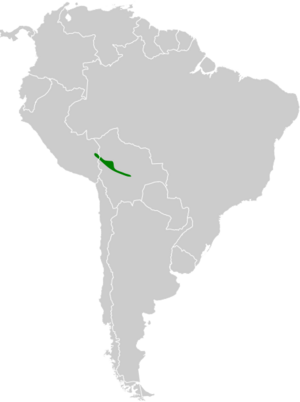Upland antshrike facts for kids
Quick facts for kids Upland antshrike |
|
|---|---|
| Conservation status | |
| Scientific classification | |
| Genus: |
Thamnophilus
|
| Species: |
aroyae
|
 |
|
The upland antshrike (Thamnophilus aroyae) is a small bird that belongs to the "typical antbird" family. It lives in the eastern Andes mountains, found in parts of Bolivia and southeastern Peru.
Contents
About the Upland Antshrike
The upland antshrike is a unique bird. It is the only species in its group, meaning there are no other very close relatives that are also called upland antshrikes.
What Does It Look Like?
The upland antshrike is about 14.5 to 15 cm (around 6 inches) long. It weighs about 20 grams, which is like four nickels. These birds have strong beaks with a hook, similar to a shrike's beak.
Male and female upland antshrikes look quite different. This is called sexual dimorphism.
- Males: Adult males have medium gray feathers on their upper body. Their head is blacker, and they have a hidden white patch on their back, between their wings. Their wings and tail are black or brownish-black. The tips of their wing feathers are white, and most of their tail feathers also have white tips. Their belly and chest are a lighter gray than their back.
- Females: Adult females have a dark reddish-brown head and neck. Their face is gray with white streaks or spots. Their upper body is dark olive-brown. Their belly and chest are a brownish-yellow color.
Both male and female birds have eyes that can be many colors, from creamy white to brown. They have a black upper beak and a lighter lower beak. Their legs and feet are gray or blue-gray. Young males look a bit like adult females, but they have yellowish spots on their wing feathers and yellowish tips on their tail feathers.
Where Does It Live?
The upland antshrike lives in the foothills of the Andes mountains. You can find it from the Puno area in southeastern Peru all the way southeast into the Cochabamba and western Santa Cruz areas of Bolivia.
This bird likes to live at the edges of wet mountain forests. It prefers thick, bushy areas and tangled vines. It almost never goes deep into the forest. You might also see it in new plant growth in places where landslides have happened or along roads. In Peru, it lives between 800 and 1000 meters (about 2,600 to 3,300 feet) high. In Bolivia, it can be found from 600 to 1900 meters (about 2,000 to 6,200 feet) high.
How Does It Behave?
Movement
The upland antshrike is thought to live in the same area all year round. It does not seem to migrate.
Feeding Habits
We don't know all the details about what the upland antshrike eats, but it mostly eats insects. It usually looks for food alone or with one other bird. Sometimes, it will join a group of different bird species that are feeding together.
It typically searches for food between 1.5 and 3 meters (about 5 to 10 feet) above the ground. However, it can sometimes feed as high as 6 meters (about 20 feet). It picks insects off leaves, stems, vines, and branches while sitting still. It also makes short flights upwards to catch prey. It likes to search for food in clumps of dead leaves caught in tangled vines.
Reproduction
Scientists do not know much about how the upland antshrike reproduces or raises its young.
Sounds and Calls
The upland antshrike's song is a fast, quick series of nose-like notes. It gets faster and ends with a note that goes down in pitch. It sounds like "wur wur-wur-wur-wur'rrrr". Its other calls include high-pitched whines, a long, deep, scratchy caw that goes down in pitch ("aarrrr"), and a soft, cat-like "awww".
Conservation Status
The IUCN (International Union for Conservation of Nature) has studied the upland antshrike. In 1988, they first thought it was "Near Threatened." Later, in 2004, they changed its status to "Least Concern." This means it is not currently in danger of disappearing.
We don't know exactly how many upland antshrikes there are, but their numbers are thought to be going down. However, no immediate dangers have been found for them. In Peru, it is considered "poorly known," and in Bolivia, it is "uncommon to locally fairly common."
Interestingly, this bird might even benefit in the short term from some changes to its habitat, like new areas of young forest growth or forest edges. But it could be in danger if large parts of its forest home are completely turned into farmland.


